Over the past century, the automotive industry has undergone a
major manufacturing revolution roughly every 40 years. From
Ford’s introduction of the assembly line to the rise of lean
manufacturing, and later the advancement of platformization and
modularization, each wave of innovation has profoundly reshaped the
industry’s landscape (figure 1).
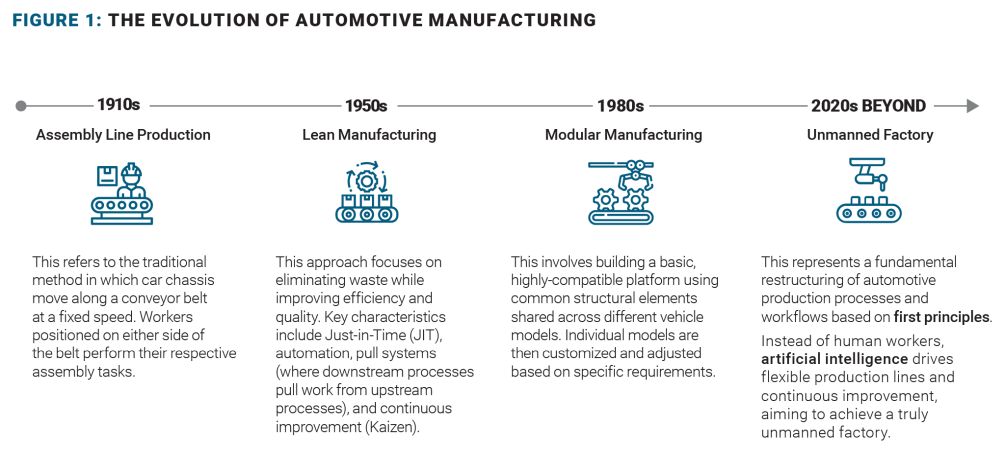
More than 40 years have passed since the last revolution of
platformization and modularization. And today, with the rapid
advancement of artificial intelligence (AI) and growing demands
from manufacturers for both greater efficiency and product variety,
the automotive industry has reached a pivotal moment, both
technologically and in the market—a new revolution.
The changing face of automotive manufacturing
The fourth revolution will increasingly be led by AI rather than
humans, ultimately paving the way for the realization of the truly
unmanned factory.
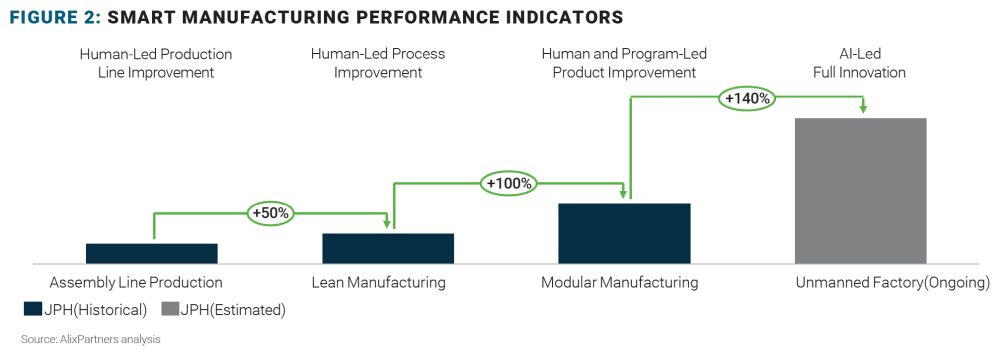
The unmanned factory will not emerge overnight. Based on the
level of AI involvement and data integration, we classify unmanned
factories into three stages (figure 3). Currently, some leading
automakers have reached the intermediate stage and are steadily
advancing toward completion, while others remain in the early
stages of implementation.
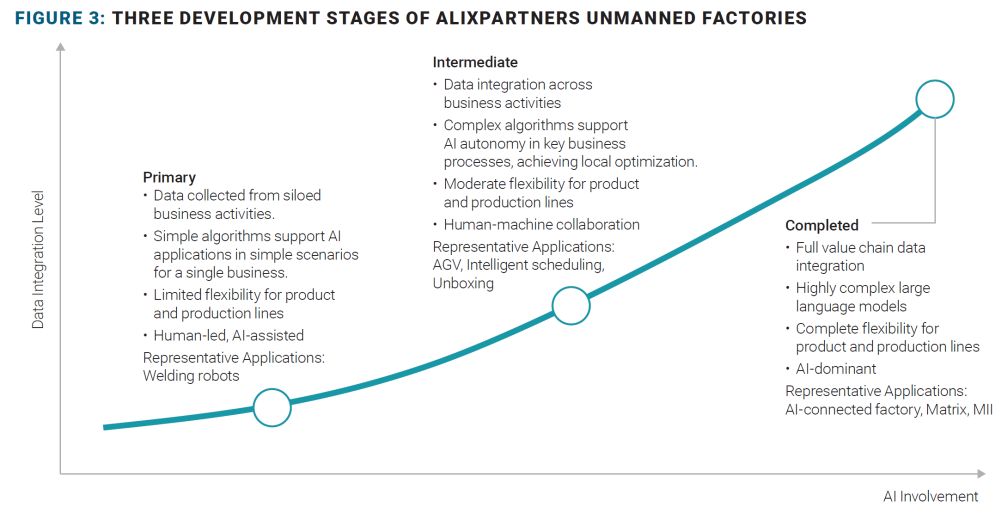
“Made in China 2.0” and new opportunities
China’s automotive industry has steadily built a
comprehensive manufacturing and supply chain system through the
strategic approach of exchanging market access for technology. With
the rise of new energy vehicles (NEVs), China has capitalized on
new opportunities and achieved significant breakthroughs. Looking
ahead, we believe China’s automotive industry will continue to
enhance its manufacturing capabilities and seize the new
opportunities presented by AI, delivering even greater value to an
increasingly diverse and expanding global market.
Development path of “Made in China
2.0”
From an investment perspective, market players in China are
increasingly focusing on AIoT (Artificial Intelligence of Things)
and process optimization to drive efficient and flexible
production. Their efforts are concentrated in three key areas:
- Reconstructing products and production lines
- Deploying highly intelligent software applications
- Integrating data and building end-to-end large language
models
Investment trend of “Made in China
2.0”
In terms of investment scale, intelligent manufacturing in
China’s automotive industry is still in its early
“pilot” stage. However, both application and investment
are expected to accelerate significantly in the coming years.
Focusing solely on use case related investment, the total amount
is projected to reach approximately RMB 180 billion by 2030 and
around RMB 460 billion by 2035.
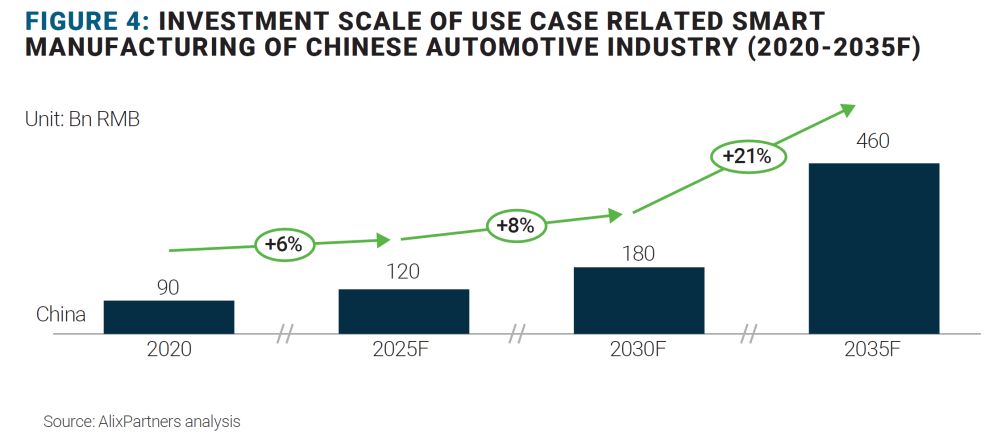
If the shared infrastructure investment is considered, like
cloud, network, computing power, the related investment will be
significantly higher. Accordingly, the infrastructure investment is
projected to reach RMB 7.3 billion in 2030 and RMB 29 billion in
2035.
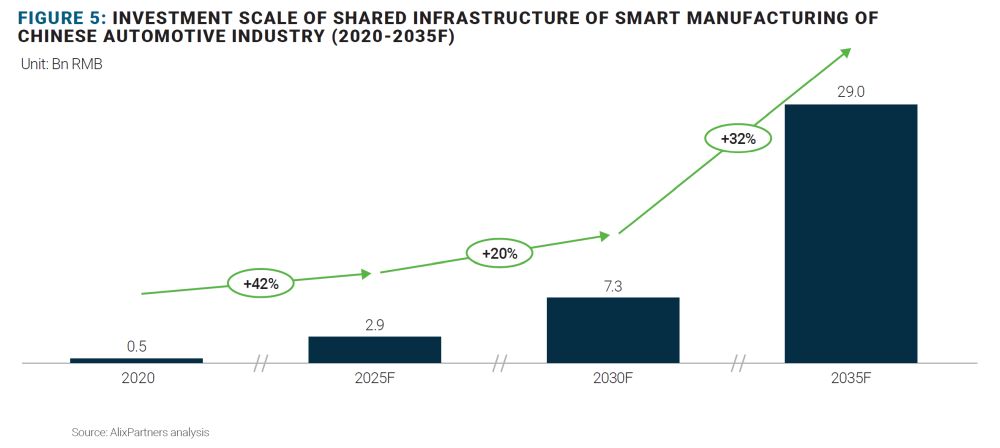
We have found that Chinese automotive companies face the
following challenges when confronted with the new round of
manufacturing revolution:
- Investment uncertainty: Many companies have an
unclear understanding of their own organization’s AI progress.
Additionally, companies frequently pursue AI solutions without
clearly identifying specific business pain points or
scenarios. - Returns uncertainty: AI delivers benefits
across multiple dimensions—cost reduction, quality
improvement, efficiency gains, and greater flexibility—but it
is difficult to consolidate these into a single
return-on-investment (ROI) metric. It’s also difficult for
companies of different sizes and maturity levels to benchmark or
learn from one another’s experiences. - Infrastructure supply risks (e.g. computing
power): Geopolitical tensions—particularly U.S.
restrictions on advanced chip exports and AI software platforms
pose significant risks to infrastructure supply. China’s
domestic chip ecosystems are still maturing, contributing to a
widening gap in high-end computing capabilities. Additionally,
extended software adaptation cycles and a shortage of
inference-optimized chips further complicate deployment. The
evolving nature of AI technology also causes structural shifts in
computing demands, adding to the complexity. - AI model and data adaptability:
General-purpose AI models often fail to meet the nuanced needs of
specific business functions and may contain algorithmic biases that
lead to unfair or inaccurate outcomes. Effective algorithm training
is heavily dependent on data volume and quality—areas where
many companies fall short. - Talent mismatch: Intelligent manufacturing
requires a workforce skilled in multiple disciplines. However,
traditional manufacturing engineers frequently lack the digital and
analytical skills necessary to support AI-driven
transformation.
Our recommendations
We conclude that, to address the challenges the intelligent
manufacturing revolution presents, companies must take a top-down
approach to defining their strategies and communicating with
internal stakeholders transparently. During implementation,
companies should apply an agile approach to iterate use cases, with
continuous improvement of models and results, rather than using
traditional IT approaches.
To ensure the success of this revolution, a solid basis of lean
manufacturing, together with a robust data environment, is a
must-have. In the meantime, a combination of AI and process
engineers, under a suitable organization setup and governance
model, will be necessary to support sustainable development.
The content of this article is intended to provide a general
guide to the subject matter. Specialist advice should be sought
about your specific circumstances.








